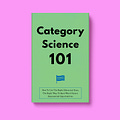Category Science 101: How To Use The Right Historical Data, The Right Way, To Spot Weird Future Exponential Opportunities
How to be Pirate Eddie Yoon.
Dear Friend, Subscriber, Category Pirate—and future Category Scientist!
The entire field of “analysis” (of any kind: habitual, financial, data usage, etc.) is backward-looking.
You are analyzing data from the past.
And what you’re looking for are insights and discoveries in data from the past that allow you to, “in a more accurate way,”create the future.
But something we don’t hear talked about very often is how, using a backward-looking lens, and the subsequent analyses that emerge from that perspective, data analysts (of all shapes and hard drive sizes) make an undiscussed, unconsidered decision that the underlying purpose of analyzing the past is to look for things that already exist, and already make sense to look for, with the hopes of extrapolating insights that allow for an understanding of how the future is going to be a continuation of the past.
It’s worth underscoring this undiscussed, unconsidered decision occurs even with the smartest people in the smartest fields. Because this assumption is driven by fear as opposed to intellect. For example, a buddy of ours is a tenured computer science professor and the chair of the department at a Top 10 university. He observed when new papers were submitted for peer review that no one would comment on it until the most senior, respected professor in the field added his or her feedback first. If the guru liked it, then everyone else liked it. If the guru trashed it, then the piling on would begin.
No one likes to be different.
No one really wants to challenge the past. Not even the smartest people in the most technical of fields where you would think subjectivity didn’t have much room.
Once the analysis is complete, and it’s confirmed the future is going to be a continuation of the past, the data analyst, or the metric-obsessed executive or founder or investor, can then optimize, reduce risk, and increase opportunities in the future based on their newfound understanding of the past.
This is the context in which the world of data analysis lives.
And this approach works great—if your goal is to incrementally optimize an existing business.
White Space Analysis
In B2B marketing, there is this thing called “White Space” analysis.
What you do is you take all your existing customers, and all the products & services they buy from you, and you create a heat map of all the products and services your existing customers don’t have. Then, you market those products and services to those customers.
(Brilliant, right?)
Back in his CMO days, Pirate Christopher’s team (led by the legendary Sue Barsamian) got so sophisticated with this “White Space” analysis at Mercury that when the company’s yearly conference rolled around, they would strategically and deliberately steer customers who attended into panels and breakout sessions that corresponded with their individual “white space.” So if you bought product A, then Mercury (and Pirate Christopher with a pirate flag and a pint o’ whisky) would find you at the conference and nudge you to go learn about Product B.
In the B2B tech world, “White Space” analysis is the one of the fastest ways to get to revenue quickly—because all you’re doing is selling existing customers on whatever thing they don’t have yet.
It’s very effective. And for many growing companies, it’s an important best practice.
But we want to be crystal clear about something…
This is not how you use data to create new categories.
Category Science 101
Data analysis uses a backward-looking lens to discover insights that prove how the future is going to be a continuation of the past.
Category Science uses a forward-looking lens to discover insights that reveal how the future is going to be different from the past.
Pirate Eddie is a Category Scientist. And what Eddie does (and gets paid handsomely to do) is analyze data and look for things in the past that help him discover how to CREATE a DIFFERENT future (and not: a future that is a continuation of the past).
For example, in his book Superconsumers he tells the story about his work with Swingline and the discovery of the “stapler Superconsumer.”
This is going to be a weird story, but “weird” is what makes Category Science work.
So grab a pint and let’s dive in!
The “Stapler Superconsumer”
Swingline hired Pirate Eddie to do some “consulting work.” Going back to our Obvious/Non-Obvious framework, this is usually the Obvious problem companies think they have, and the Obvious solution they think they need. (“I just need someone to come in, look at the data, tell us what we’re doing wrong, and then we can fix it so the past can go on being the future.”
But Pirate Eddie isn’t a consultant who looks at data through a backward-looking lens.
Keep reading with a 7-day free trial
Subscribe to Category Pirates to keep reading this post and get 7 days of free access to the full post archives.




